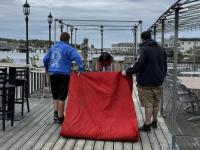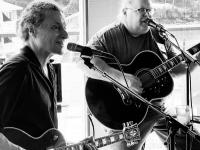TIF talks draw full house to town office
By the end of the night on October 9, Paul Coulombe of Southport had offered the Town of Boothbay a $2.5 million money-back guarantee in defense of the proposed Boothbay Village and Industrial Park TIF district.
“I think this town needs a big infusion of capital,” Coulombe told a full house at the Boothbay Town Office. “I think you need to open your doors, and open your eyes and open your minds to a better future for the town.”
Coulombe, whose company has overseen a revival of the Boothbay Harbor Country Club, has worked with the town for five months to create a TIF district that proponents claim will shape the economic future of the Boothbay region.
A TIF, or tax incremental financing district would freeze the property value within a 272-acre district in Boothbay, and collect new tax revenue on the increased property value generated by commercial development. According to the selectmen, the TIF district, which includes the Boothbay Harbor Country Club, could rake in more than $4.7 million for the town over next 30 years, and save taxpayers more than $800,000.
But not everybody roundly accepts the TIF proposal or the $2.5 million bond that will come before voters on the November 5 referendum. Fred Kaplan of Boothbay voiced his opposition at the October 9 selectmen’s meeting.
“You've gone a long way down the road and created a substantial plan ... without one bit of public input until the moment that plan was revealed to us,” Kaplan said.
Kaplan said the arithmetic the selectmen used for justifying the TIF was wishful thinking.
“The issue is that the clubhouse will not increase the value sufficiently to pay off the bond. There has to be more investment in that golf course,” Kaplan said.
Coulombe said he has spent nearly $11 million on the golf course and intends to spend $20 more million in the next 18 months.
When Coulombe purchased the golf course last May, Town Manager Jim Chaousis reached out to see what could be done between the developer and the town.
Coulombe was interested in revamping the entrance to the golf course, Chaousis said, which led to discussions of traffic improvements and opportunities with the Maine Department of Transportation.
Chaousis suggested a TIF district could create new revenue to fund long-term improvements in the town, which could better the chances of the securing matching funds from the state.
“We were able to come to some real understandings of what we could do with this,” Chaousis said. “Paul thought there was enough merit there that he hired one of the best TIF attorneys in the state of Maine.”
Coulombe also hired an appraiser to estimate the country club’s projected property value. His attorney took that information and showed the town how it would play out in a TIF scenario. On September 11, the selectmen unanimously supported the plan.
Boothbay currently has two existing TIF districts at Washburn & Doughty and Hodgdon Yachts. Both TIFs have a 20-year lifespan that shelters Boothbay from adverse adjustments to Lincoln County taxes and state subsidies.
By the end of each term, the Hodgdon Yachts TIF will have saved Boothbay residents as much as $74,799 in taxes. Washburn & Doughty’s TIF will have saved the town’s taxpayers $277,360, according to the TIF records. If those TIF districts were not in place, the town as a whole (including taxpayers) would be responsible for paying the increase in taxes over that period of time.
According to the selectmen, the Boothbay Village and Industrial Park district could shelter Boothbay by at least $800,000 based on a flat tax rate. If the tax rate increases in the next 30 years, the town could save more money.
The big difference between the existing TIF districts and the proposed TIF district is the former districts receive a 75 percent annual tax break called a credit enhancement agreement, whereas the Boothbay Harbor Country Club would not receive a credit enhancement agreement.
Many residents have criticized the selectmen for endorsing a traffic improvement plan that comes packaged with the $2.5 million dollar loan.
One of the biggest concerns is a rotary recommended around the monument in the Boothbay common. The design was based on a 2002 study conducted by MDOT. Contrary to the rumors, Chaousis said the November 5 ballot is not asking voters to decide on a rotary. The selectmen are just presenting ideas of what is possible with the money generated by a TIF fund, Chaousis said.
Kaplan continued to question why the town is willing to put their trust solely on Coulombe's word that he'll spend the money on the golf course.
Coulombe countered Kaplan with a bold statement.
“For any reason I'm not here and I don't build that clubhouse, I'll put in writing that I will pay the $2.5 million myself,” Coulombe said.
Chaousis said before Coulombe made the announcement, the weakest part of the plan was the risk that he would not follow through with developing the country club.
“We were sure he would build it,” Chaousis said. “Now if he's going to pay the loan, there's no more uncertainty.”
Event Date
Address
United States





















